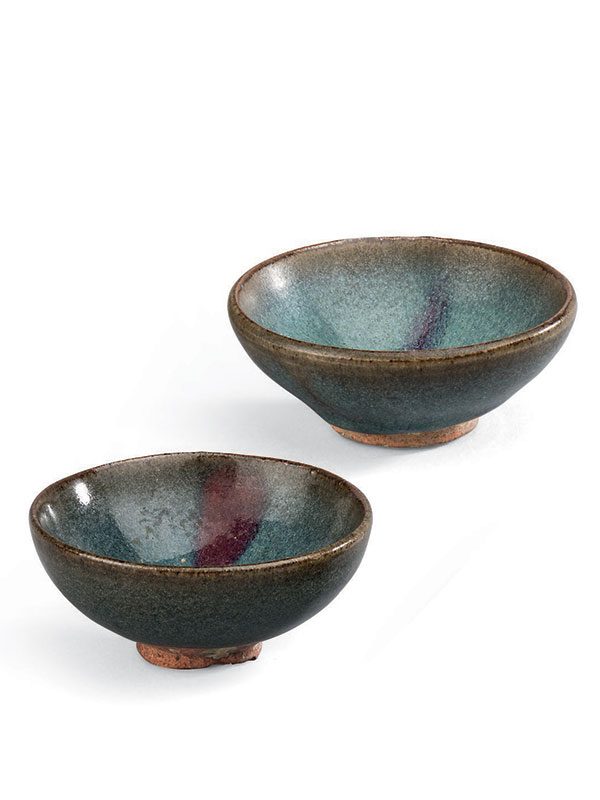Two Jun stoneware bowls
Two small stoneware bowls, each with a sturdily potted body supported on a low splayed foot. The steeply rounded sides straighten and curve in at the rim. Each bowl is covered in a blue glaze that turns a transparent olive-brown tone at the rim. The interiors are enlivened by a single splash of purple and reddish purple that extends from the rim to the centre of the bowl’s interior. On the exterior the glaze stops short of the unglazed foot, where it pools in thick drops. The unglazed stoneware is fired to an orange tone, with some small specks of grit attached to the base and the foot.
Notable for their small size, which lead to the common reference of ‘bubble’ bowls, these two small Jun bowls would appear to be too small for drinking tea and might instead have been used for drinking wine. Their incurving rims, as opposed to a flared rim that was preferred for tea drinking, further strengthen this hypothesis. It is clear from early references that the colour of the ceramic wares was valued for its ability to enhance the colour of the tea, an important criterion in the early tea cult. It is likely that the colours of Jun ware and tea were not considered compatible.1 This type of small Jun ‘bubble’ bowl had already been used during the Northern Song dynasty (960 – 1127). The current examples, with their coarser bodies in orange tone, are likely to have been produced later during the Jin or Yuan dynasty. Two comparable Jun ‘bubble’ bowls with purple splashes, of similar size and dated earlier to the Northern Song dynasty, 11th – 12th century, are in the Meiyintang collection.2 Another Northern Song example is in the collection of the Victoria and Albert Museum.3 Examples dated to the Jin or Yuan dynasty can be found in the collections of the Metropolitan Museum of Art4 and the British Museum.5
1 Ribeiro, S. ed., Arts from the Scholar’s Studio, Oriental Ceramic Society, Hong Kong, 1986, p. 260
2 Krahl, R. Chinese Ceramics from the Meiyintang Collection, Vol. Three (II), Paradou Writing, London, 2006, nos. 1459 & 1460, p. 459
3 Kerr, R. Song Dynasty Ceramics, Victoria and Albert Museum, London, pl. 26, p. 34
4 The Metropolitan Museum online collection archive, accession number: 26.292.33
5 The British Museum online collection archive, museum number, PDF.53
鈞窯小碗兩件
金至元 十三 – 十四世紀
徑:10 公分 高:4 公分, 4.6 公分
鈞釉小碗, 斂圓口,深弧壁,矮圈足。形若蓮蓬,通體施藍釉,口緣呈米黃色,藍釉呈天青與海水藍 色,釉面浮現紅紫色斑紋,藍天彩霞,曼妙多姿。釉面淺開片,施釉至碗下緣,足壁、地緣處無釉,露 紅褐色陶胎。此類鈞窯天藍釉小碗,由於其器形小巧,釉面變換鮮艷,近年來在西方常被稱為「泡泡 碗」,但此種稱謂並未在過去文獻中提及。此類小碗,應為當時飲酒之佳器。宋代鈞窯製品常以單一的 月白、天青、粉青為主,之後燒造工藝進步,工匠通過加入氧化鐵使得釉色在不同溫度下產生改變,形 成巧奪天工的紫紅色斑紋。玫茵堂藏一對鈞窯紫斑小碗,大小相當,定年為北宋製品。金至元代鈞窯小 碗,可見於紐約大都會博物館及大英博物館藏。

